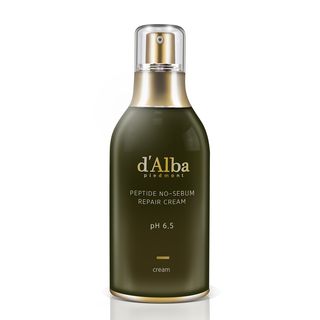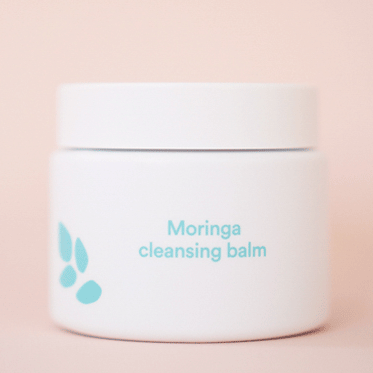Looking for an alternative to the $68 Drunk Elephant Protini Polypeptide Cream? Meet the d’Alba Piedmont Peptide No-Sebum Repair Cream! Haven’t used the Drunk Elephant one before? Read on to find out why peptides are the perfect anti-aging ingredient.
Our community is always asking us for K-beauty dupes for popular pricey products. Recently, Drunk Elephant’s Protini Polypeptide Cream has been a top request so we went searching. Our journey led us to the d’Alba Piedmont Peptide No-Sebum Repair Cream product page on Soko Glam, where we discovered multiple rave reviews comparing it to the Protini cream.
Customers with combination skin seem to swear by this product, one going so far as to call it “a combo skin holy grail”. Another commenter wrote, “I did a side by side comparison of DE Protini and d’Alba Peptide No-Serum and d’Alba wins hands down for me. It is less expensive for the same amount of product but looks so bougie on my counter. The texture is beyond compare…I feel hydrated and moisturized without feeling weighed down.”
RELATED: Affordable K-Beauty Dupes For the Most Buzzed About Western Products
What are peptides?
Before you decide whether or not to try either of these products, let us explain exactly what your skin is in store for.
Peptides are a scientifically-backed ingredient that have a significant effect in helping to delay the signs of aging and increase firmness, elasticity, and collagen production. They do this by communicating to the body that new collagen needs to be produced in order to make up for what we lose naturally with age.
They’re especially useful because they are essentially a fragmented building block of a protein. This means that they absorb into the skin more easily than actual complete proteins (like collagen).
And there are hundreds of variations depending on the combination of amino acids that make them up. For example, collagen peptides can help send signals to your cells to generate more collagen, working to combat the body’s natural loss of elasticity and collagen breakdown as we age.
RELATED: Ingredient Spotlight: How Peptides Minimize the Appearance of Wrinkles
Other peptide variations that are popular in skin care include copper peptides and neuropeptides. Neuropeptides work to relax the face by smoothing out wrinkles and fine lines. If you’ve ever tried the Hanacure mask, one of the main ingredients in that is neuropeptides. They have been described as a “non-invasive alternative to Botox”, but keep in mind that while peptides are an amazing ingredient, they cannot replace actual cosmetic procedures.
Copper peptides are another type of peptide, and they work to heal damaged skin. They have also been clinically proven to be an antioxidant, therefore helping to protect skin against harsh environmental factors like free radicals and pollution.
How the Drunk Elephant Protini Polypeptide Cream Compares to the d’Alba Piedmont Peptide No-Sebum Repair Cream
The DE cream’s ingredient list includes a combination of signal peptides, growth factors, and amino acids. It was formulated by the request of founder Tiffany Masterson’s mother, who wanted a product to address general collagen concerns. It comes in an airtight jar and pump to prevent exposure and oxidization. The word “Protini” in its name comes from an Afrikaans word meaning “protein”, and it’s meant to function as a protein powder for your skin.
The cream itself is an intensely thick formula. The peptide-complex works to help reduce lines, wrinkles, and sun damage, while the amino acids act as support by strengthening and moisturizing the skin barrier. Since its launch, it’s been a near-permanent fixture on Sephora’s best-sellers list. A good majority of people on the site swear that it makes their skin firmer, plumper, and smoother.
The two most common complaints that stand out are (of course) the price and the potential for breakouts. It retails for $68 for 1.69 oz. and when applied, you have to be okay with a thicker texture. If you’re looking for a product to combat both acne and fine lines, then this may not be the product for you.
The d’Alba Piedmont is priced at a more reasonable $45 for 1.69 fl.oz. It too comes in an airtight bottle with a pump and has a somewhat thinner consistency than the DE, while still being a far cry from watery or light. Like the DE version, the d’Alba cream’s ingredient list includes low molecular peptides and 20 essential amino acids and minerals, which all work to help firm and improve skin elasticity, wrinkles, and fine lines. It’s also formulated with calamine powder and BHAs to help fight acne, gently remove old skin cells, target sebum, and soothe sensitive areas.
The product is especially exciting because there’s a distinct lack of anti-aging products out there for combination skin types, and this one fills that space.
You can use the cream – which has a nice herbal scent to it – both morning and night, and it helps to keep the shine at bay. It doesn’t leave your skin looking totally matte, but definitely leaves a healthy glow behind. Pair it with the d’Alba Peptide No-Sebum Balancing Toner for a perfect anti-aging combo.
RELATED: 3 Women in Their 40s, 50s, and 60s Share Their Honest Opinions on a New Anti-Aging Toner
Bottom Line
If you’re interested in stepping into the world of peptides, or you’re looking for something a little bit more affordable than what you already use, then the d’Alba option would be our go-to choice. If you’re looking for a heavier formula, then you might want to check out the Drunk Elephant version. Let us know which one you would choose in the comments.

Reviews + Advice
Meet the K-Beauty Cream That’s a More Affordable Dupe For Drunk Elephant’s Protini Polypeptide Cream
SHARE










